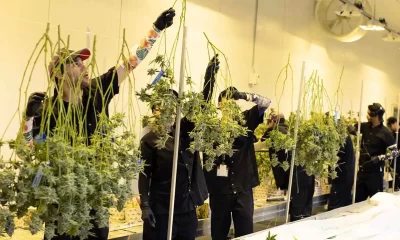Business
Is Solar Power the Future of Cannabis Growing if Electricity Is Such A Major Cost?

Solar panels for indoor cannabis grows could improve margins and help the environment!
Installing solar panels in an indoor system of cultivation helps to significantly reduce energy consumption and the resulting cost of electricity.
Every farmer knows that indoor cultivation is quite energy-intensive. In fact, according to the data available, about 1% of the total energy supplied in the US goes into the indoor cultivation of plants. It is also predicted that by 2035, the number will surge up to 3%.
As regards indoor cannabis cultivation, it is estimated that all equipment used in the cultivation of high-quality buds in a grow room of 3.5m3 will use approximately 13,000 kWh of electricity annually. Furthermore, the equipment used to cultivate healthy and happy cannabis plants produces so much CO2. To have a clear picture, cultivating a kilo of cannabis bud will give 4.3 tons of CO2.
Because of the secrecy involved in indoor cultivation, its impacts on the environment and ozone layer could not have been determined till now. But, with cannabis legalization sweeping across the globe, numbers are beginning to roll in, indicating that indoor cultivation is not an eco-friendly venture.
Fortunately, there are several ways to go about these said problems. A solution is to move to outside cultivation, go back to the beginning and allow the wind to take care of air conditioning and the sun to be the lighting. However, this is not an option for many growers who reside in countries where cannabis is still considered illegal. Hence, there is a need to hide the plant.
Now, the other solution farmers in this kind of situation have all depends on the sun, although in a different approach. We are certainly referring to Solar Panels.
Setting up Solar Panels
Grow rooms powered by Solar panels are not the latest inventions. This kind of setup has been popular due to its expensive initial cost of investment. But, ain’t solar panels becoming cheaper and more efficient in energy conversion, the issue of cost is slowly fading away.
Another reason why solar panel setups are not popular is the lack of technical know-how on the grower’s part. Many growers would rather go for tried and tested methods instead of experimenting with solar panel setups. This is the reality given there’s little room for an average grower to experiment since it could lead to crop losses and ultimately financial losses.
For close to a decade now renewable energy production has increased significantly courtesy of China’s high levels of production. Meanwhile, there has also been a steady advancement in technology in the same period causing renewable energy to become a more stable energy source. But, considering the working principles of solar energy, sodium light pressure in grow rooms can prove difficult to power. Sodium light pressure needs a lot of power to work which implies more batteries will be needed which will also take up more space.
Luckily, switching to CFLs or LEDs would help solve this situation, but how many expert growers are willing to make such a sudden switch? The best approach now is to design a hybrid system – one that uses both solar and the grid. This is a perfect solution to the dilemma. It offers a lot of renewable energy benefits while significantly reducing the cost of electricity.
For many who would want nothing less than a fully functional solar-powered grow room, the latest innovations in electricity storage come to the rescue. Today, high-capacity batteries that can produce up to 10kWh and are efficiently charged by solar energy have been developed. These batteries can also be charged with electricity during cheap hours and so can be used in a hybrid system. A good example of such a battery would be the high-end solar Tesla battery which was made available in the market just last year.
The Outcome
Setting up a completely renewable energy system for indoor cultivation is an expensive venture. Picture buying the expensive 10kWh battery manufactured by Tesla which is not even sold at local utility stores. You would need to buy solar panels too which are not cheap either, although prices vary from one country to the next.
Let’s assume a grow room of size 0.6m by 0.6m needs total energy of 2kW and solar panels cost $7 per watt. That’s a total of $14,000 spent on solar panels and it’s obvious that you spend more with a bigger room. For the Tesla battery, one costs about $3,500, and buying just one certainly won’t cut it.
Although one vital thing you should know is that all of this is a one-time purchase. Once the panels are installed, they start paying you back. The panels won’t need changing and maintenance is minimal (periodic cleaning of the panel surface). Efficiency tends to drop per year though, with an estimation of 0.5% drop in efficiency which is highly negligible. Most panels are said to maintain an efficiency of 80% after 25 years of use.
The batteries, on the other hand, will need to be frequently changed as capacity starts decreasing from the first day. Battery capacities after five years would have degraded considerably. While it comes off as expensive to set up this system, understand that the cost of electricity can reach these numbers in years to come depending on your operational size.
Taking the costs to establish this system into consideration, the ROI could range between three to four years. But as technological advancement meets the field, the time frame keeps reducing. Imagine not having electricity troubles or worrying about electricity costs, or not getting a standby generator to avoid suspicion. Also, imagine not contributing to the carbon footprint in the environment – that’s what solar panels and renewable energy offer.
Conclusion
Frankly, venturing into establishing a solar-paneled powered grow room requires a lot of logistics and planning. And most importantly, a large pool of investment capital. For growers who already have a working setup that doesn’t involve any renewable energy sources, it would be best to ease into the renewable system, especially if you operate a huge setup.
However, for growers just building a new setup, integrating solar panels in the system should be something of consideration. Because the truth is told, self-sustainable grow rooms are the future of indoor cannabis cultivation.
Business
New Mexico cannabis operator fined, loses license for alleged BioTrack fraud

New Mexico regulators fined a cannabis operator nearly $300,000 and revoked its license after the company allegedly created fake reports in the state’s traceability software.
The New Mexico Cannabis Control Division (CCD) accused marijuana manufacturer and retailer Golden Roots of 11 violations, according to Albuquerque Business First.
Golden Roots operates the The Cannabis Revolution Dispensary.
The majority of the violations are related to the Albuquerque company’s improper use of BioTrack, which has been New Mexico’s track-and-trace vendor since 2015.
The CCD alleges Golden Roots reported marijuana production only two months after it had received its vertically integrated license, according to Albuquerque Business First.
Because cannabis takes longer than two months to be cultivated, the CCD was suspicious of the report.
After inspecting the company’s premises, the CCD alleged Golden Roots reported cultivation, transportation and sales in BioTrack but wasn’t able to provide officers who inspected the site evidence that the operator was cultivating cannabis.
In April, the CCD revoked Golden Roots’ license and issued a $10,000 fine, according to the news outlet.
The company requested a hearing, which the regulator scheduled for Sept. 1.
At the hearing, the CCD testified that the company’s dried-cannabis weights in BioTrack were suspicious because they didn’t seem to accurately reflect how much weight marijuana loses as it dries.
Company employees also poorly accounted for why they were making adjustments in the system of up to 24 pounds of cannabis, making comments such as “bad” or “mistake” in the software, Albuquerque Business First reported.
Golden Roots was fined $298,972.05 – the amount regulators allege the company made selling products that weren’t properly accounted for in BioTrack.
The CCD has been cracking down on cannabis operators accused of selling products procured from out-of-state or not grown legally:
- Regulators alleged in August that Albuquerque dispensary Sawmill Sweet Leaf sold out-of-state products and didn’t have a license for extraction.
- Paradise Exotics Distro lost its license in July after regulators alleged the company sold products made in California.
Golden Roots was the first alleged rulebreaker in New Mexico to be asked to pay a large fine.
Source: https://mjbizdaily.com/new-mexico-cannabis-operator-fined-loses-license-for-alleged-biotrack-fraud/
Business
Marijuana companies suing US attorney general in federal prohibition challenge

Four marijuana companies, including a multistate operator, have filed a lawsuit against U.S. Attorney General Merrick Garland in which they allege the federal MJ prohibition under the Controlled Substances Act is no longer constitutional.
According to the complaint, filed Thursday in U.S. District Court in Massachusetts, retailer Canna Provisions, Treevit delivery service CEO Gyasi Sellers, cultivator Wiseacre Farm and MSO Verano Holdings Corp. are all harmed by “the federal government’s unconstitutional ban on cultivating, manufacturing, distributing, or possessing intrastate marijuana.”
Verano is headquartered in Chicago but has operations in Massachusetts; the other three operators are based in Massachusetts.
The lawsuit seeks a ruling that the “Controlled Substances Act is unconstitutional as applied to the intrastate cultivation, manufacture, possession, and distribution of marijuana pursuant to state law.”
The companies want the case to go before the U.S. Supreme Court.
They hired prominent law firm Boies Schiller Flexner to represent them.
The New York-based firm’s principal is David Boies, whose former clients include Microsoft, former presidential candidate Al Gore and Elizabeth Holmes’ disgraced startup Theranos.
Similar challenges to the federal Controlled Substances Act (CSA) have failed.
One such challenge led to a landmark Supreme Court decision in 2005.
In Gonzalez vs. Raich, the highest court in the United States ruled in a 6-3 decision that the commerce clause of the U.S. Constitution gave Congress the power to outlaw marijuana federally, even though state laws allow the cultivation and sale of cannabis.
In the 18 years since that ruling, 23 states and the District of Columbia have legalized adult-use marijuana and the federal government has allowed a multibillion-dollar cannabis industry to thrive.
Since both Congress and the U.S. Department of Justice, currently headed by Garland, have declined to intervene in state-licensed marijuana markets, the key facts that led to the Supreme Court’s 2005 ruling “no longer apply,” Boies said in a statement Thursday.
“The Supreme Court has since made clear that the federal government lacks the authority to regulate purely intrastate commerce,” Boies said.
“Moreover, the facts on which those precedents are based are no longer true.”
Verano President Darren Weiss said in a statement the company is “prepared to bring this case all the way to the Supreme Court in order to align federal law with how Congress has acted for years.”
While the Biden administration’s push to reschedule marijuana would help solve marijuana operators’ federal tax woes, neither rescheduling nor modest Congressional reforms such as the SAFER Banking Act “solve the fundamental issue,” Weiss added.
“The application of the CSA to lawful state-run cannabis business is an unconstitutional overreach on state sovereignty that has led to decades of harm, failed businesses, lost jobs, and unsafe working conditions.”
Business
Alabama to make another attempt Dec. 1 to award medical cannabis licenses

Alabama regulators are targeting Dec. 1 to award the first batch of medical cannabis business licenses after the agency’s first two attempts were scrapped because of scoring errors and litigation.
The first licenses will be awarded to individual cultivators, delivery providers, processors, dispensaries and state testing labs, according to the Alabama Medical Cannabis Commission (AMCC).
Then, on Dec. 12, the AMCC will award licenses for vertically integrated operations, a designation set primarily for multistate operators.
Licenses are expected to be handed out 28 days after they have been awarded, so MMJ production could begin in early January, according to the Alabama Daily News.
That means MMJ products could be available for patients around early March, an AMCC spokesperson told the media outlet.
Regulators initially awarded 21 business licenses in June, only to void them after applicants alleged inconsistencies with how the applications were scored.
Then, in August, the state awarded 24 different licenses – 19 went to June recipients – only to reverse themselves again and scratch those licenses after spurned applicants filed lawsuits.
A state judge dismissed a lawsuit filed by Chicago-based MSO Verano Holdings Corp., but another lawsuit is pending.
Source: https://mjbizdaily.com/alabama-plans-to-award-medical-cannabis-licenses-dec-1/
-

 Business2 years ago
Business2 years agoPot Odor Does Not Justify Probable Cause for Vehicle Searches, Minnesota Court Affirms
-

 Business2 years ago
Business2 years agoNew Mexico cannabis operator fined, loses license for alleged BioTrack fraud
-

 Business2 years ago
Business2 years agoAlabama to make another attempt Dec. 1 to award medical cannabis licenses
-

 Business2 years ago
Business2 years agoWashington State Pays Out $9.4 Million in Refunds Relating to Drug Convictions
-

 Business2 years ago
Business2 years agoMarijuana companies suing US attorney general in federal prohibition challenge
-

 Business2 years ago
Business2 years agoLegal Marijuana Handed A Nothing Burger From NY State
-

 Business2 years ago
Business2 years agoCan Cannabis Help Seasonal Depression
-

 Blogs2 years ago
Blogs2 years agoCannabis Art Is Flourishing On Etsy









